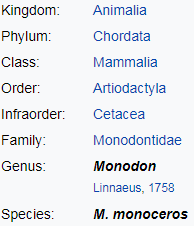Narwhal
The narwhal (Monodon monoceros),
or narwhale, is a medium-sized toothed whale that
possesses a large "tusk" from
a protruding canine tooth.
It lives year-round in the Arctic waters around Greenland, Canada, and
Russia.
Each
year, they migrate from bays into the ocean as summer comes. In the winter, the
male narwhal’s occasionally dive up to 1,500 m (4,920 ft) in depth,
with dives lasting up to 25 minutes. In winter, it feeds on benthic prey, mostly flatfish, under dense pack ice. During the summer,
narwhals mostly eat Arctic cod and Greenland halibut, with other
fish such as polar cod making
up the remainder of their diet
Physical Appearance
Excluding
the male's tusk, the total body size can range from 3.95 to 5.5 m (13 to
18 ft); the males are slightly larger than the females. The average weight
of an adult narwhal is 800 to 1,600 kg (1,760 to 3,530 lb). Narwhals
do not have a dorsal fin, and their
neck vertebrae are
jointed like those of other mammals, not fused as in dolphins and most whales.
The tusk is actually a canine tooth that grows
throughout life, reaching a length of about 1.5 to 3.1 m (4.9 to
10.2 ft). It is hollow and weighs around 10 kg (22 lb). About
one in 500 males has two tusks,Only about 15 percent of females grow a tusk
which typically is smaller
than a male tusk, with a less noticeable spiral. Wild narwhal
using their bizarre tusks
to hunt Arctic cod by hitting and stunning them, making them easier to consume. It
has a small kinda unnoticeable eyes, but if you look close enough, you’ll see
it. Like other whales, narwhal’s have a blowhole which helps them to breathe. Its
fluke shape will affect its swimming performance, the male’s fluke helps
account drag caused by their tooth, while the female’s fluke provides speed for
diving. Narwhal’s have pair of flippers
Life
Cycle
Monodon monoceros is a seasonal breeder. The gestation period is about
15.3 months, with mating occurring in March-May and calving in July-August of
the following year. A single calf is often the result of gestation, yet
some twins have been recorded.
The calf (baby narwhal) is born live and stays with
its mother for 20 months after birth. Baby narwhals are usually brown with no
spots or flecks. Males are not born with their tooth/tusk. The male calf
sexually matures at the age of 8-13 years old while the female will
sexually mature at 4-8 years old. At birth narwhals are
usually 5 feet long and 80kg in weight.

1. What is narwhal conservation status?
BalasHapusA. Least concerned
B. Extinct
C. Extinct in the wild
D. Endangered
2. What is narwhal diet?
A. Arctic cod
B. Ant
C. Shark
D. Human
3. What does “narwhal” mean?
A. Black whale
B. Flying whale
C. Unicorn
D. Corpse whale
4. What does narwhal tusk do?
A. To kill its prey
B. To stun its prey so they’re easy to consume
C. To fight with predator
D. To fly
5. How do narwhal communicate with each other?
A. Using “click” sound
B. Using “knock” sound
C. Using “whistle” sound
D. All of the above is right